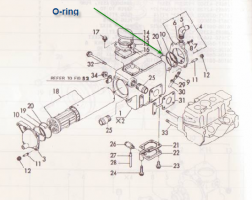simdim
Member II
Folks,
Now since we had re-raked the mast our e29 sails sweet ( thanks to everyone on this forum for the help), but Admiral had noticed that there is exhaust smell in the cabin and port lazareth.
( thanks to everyone on this forum for the help), but Admiral had noticed that there is exhaust smell in the cabin and port lazareth.
PO had retrofitted Yanmar 2gm20 and from what I can see all ventilation hoses are a mess - there are holes and kinks int exhaust vent hose and kinks in the intake. Also exhaust blower is not firmly attached to the engine compartment. Should I start from installing new vent hoses and inline blower like this one http://www.defender.com/product.jsp?path=-1|6880|46775|732133&id=714108&cartId=1027884 and hard wire it to the ignition or should I start looking for the exhaust leaks?
With exhaust leaks - unlike the car where it is all easily accessible - how one goes about looking for leaks on a boat exhaust system?
Cheers,
Now since we had re-raked the mast our e29 sails sweet
 ( thanks to everyone on this forum for the help), but Admiral had noticed that there is exhaust smell in the cabin and port lazareth.
( thanks to everyone on this forum for the help), but Admiral had noticed that there is exhaust smell in the cabin and port lazareth. PO had retrofitted Yanmar 2gm20 and from what I can see all ventilation hoses are a mess - there are holes and kinks int exhaust vent hose and kinks in the intake. Also exhaust blower is not firmly attached to the engine compartment. Should I start from installing new vent hoses and inline blower like this one http://www.defender.com/product.jsp?path=-1|6880|46775|732133&id=714108&cartId=1027884 and hard wire it to the ignition or should I start looking for the exhaust leaks?
With exhaust leaks - unlike the car where it is all easily accessible - how one goes about looking for leaks on a boat exhaust system?
Cheers,

 ...
...